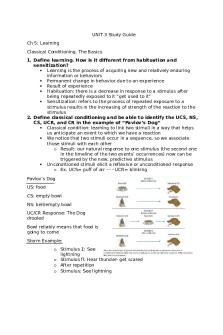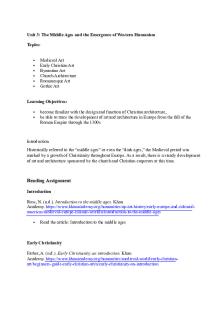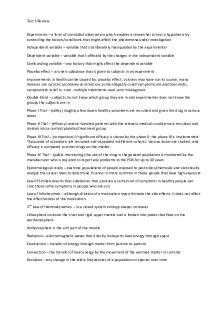TFM 160 Unit 03 - Unit 3 Study Guide (mise-en-scene and cinematography) PDF

| Title | TFM 160 Unit 03 - Unit 3 Study Guide (mise-en-scene and cinematography) |
|---|---|
| Author | Dhruv Vij |
| Course | Section Cinema as Art and Communication |
| Institution | San Diego State University |
| Pages | 7 |
| File Size | 84.6 KB |
| File Type | |
| Total Downloads | 103 |
| Total Views | 150 |
Summary
Unit 3 Study Guide (mise-en-scene and cinematography)...
Description
TFM 160 / Unit 03 Study Guide / Voytilla
1
Chapter 5: Mise-en-Scène 1. What is mise-en-scène? What is the literal meaning of the phrase? What do we mean by this phrase more generally when we discuss movies? Sum of everything the audience sees and hears. Mise-en-scene is “staging the scene.” It refers to the overall look and feel of the movie. 2. What are the two major visual components of mise-en-scène? Design – Process by which the look of the settings, props, lighting, costumes, and actors is determined. Physical elements. Composition – Organization, distribution, balance, and general relationship of actors and objects within the space of each shot. 3. What are the principal responsibilities of the production designer, and when is the production designer usually brought into the film production (during preproduction, production, or post-production?) Is the one who works with the director and director of photography. He is responsible for the overall design concept, supervises the department that create a movie’s look. Pre-production.
4. What are the major elements of cinematic design? (see “Elements of Design” in your textbook) 1) Setting, décor, properties 2) Hairstyle, makeup, design These two are the major elements. All 5 of them are elements of Mis-en-Scene. 3) Lighting – Quality, direction, source, color 4) Stage performance 5) Movement / kinesics: a) Movement of objects and characters (Blocking) b) Movement of the Frame (the moving frame)
TFM 160 / Unit 03 Study Guide / Voytilla 5. What is three-point lighting? System which uses key, fill, and back lighting. 6. How is the lighting for any movie look determined by its quality, ratio, and direction? Explain these terms and the effect each has on the overall lighting. (see video tutorial “Lighting”, located in Chapter 6 Video Tutorials) Quality – Hard light which is directly from source. Creates a fine line between shadows and illumination. Soft light doesn’t come from source, it is diffused, that is, hits subject at variety of different angles. Ratio – Relative relationship between illumination of light and shadow. Direction – Light usually comes at a 45-degree angles. 7. What is composition? What are the two major elements of composition? Organization of a shot, its distribution, balance, and general relationship with objects and figures. Two major elements are framing and kinesics. 8. What are the two basic types of movement we see on-screen? Movement of objects and characters (Blocking) Movement of the Frame (the moving frame) Additional Terminology:
Properties (props) - objects that help us understand the characters by showing their preference in such things
Sound Stage - a windowless, soundproof, professional shooting environment that is usually several stories high and can cover an acre or more of floor space
Chiaroscuro - the use of deep gradations and subtle variations of lights and darks within an image
Framing - What is seen on the screen, what filmmakers want us to see.
Kinesis - What moves on the screen. Movement of objects and characters within the frame.
2
TFM 160 / Unit 03 Study Guide / Voytilla
3
Familiar Image – Repetition of compositions, graphic elements, sounds, sequence to help understand the audience. It is also the usage of images that will resonate with certain demographics of an audience, therefore enhancing their reaction of whatever it is they are seeing.
Blocking - Movement of object and frames.
Three-point Lighting - System which uses key, fill, and back lighting (edge or rim light).
Key Light - Biggest and brightest light. Leads to a high ratio which has bright illumination and dark shadow.
Fill Light - Fills in shadows.
Backlight - Light is behind the subject, facing the camera. Adds a dark color to a character. Adds a shine / rims of brighter light called edge or rim lighting.
Lighting Ratio - Ratio between light and its shadows.
Low-key Lighting - High contrast, high ratio, and great difference between shadow and illumination. Used for more dramatic situations, crime dramas horror films. Low fill.
High-key Lighting - Low ratio that is less difference between shadow and illumination. Used in comedies and less dramatic films. High fill.
Halloween Lighting - Lighting underneath the subject, it reverses the order of shadow and illumination.
Top Lighting - light that comes from above, top.
Frontal Lighting - Light comes from the same angle as the camera.
Hard lighting - Light which is directly from source. Creates a fine line between shadows and illumination. Good for scary, tense, dramatic situations.
Soft lighting - Light doesn’t come from source, it is diffused, that is, hits subject at variety of different angles. Used on glamorous stars, romantic situations, lighter moments.
TFM 160 / Unit 03 Study Guide / Voytilla
4
Head Room - Amount of space above the subject’s head in the composition of the frame.
Lead Room - space give to the opposite side of the frame from that of the character whose lateral movement is tracked by the camera. Helps balance composition. Room given in direction of which subject is moving.
Eye Room – Space placed on the side of the frame where the subject is looking. Room given where subject is looking.
Negative Space - Intentionally empty space within a composition which creates an expectation to be filled, that something will arrive and restore the composition balance.
Deep Space Composition - Emphasized depth. Places importance in visual or narrative on either foreground, middle ground, or background. Conveys information, mood, or meaning. Distance conveys the emotional distance.
Compositional Stress – Mood or meaning created by intentionally framing subjects and objects in such a way that denies viewer expectation of a balanced composition.
Rule of thirds breaks the frame into three vertical sections and three horizontal sections, resulting in a grid.
Chapter 6: Cinematography 1. What are the differences among a setup, a shot, and a take? Shot – An uninterrupted run of the camera Take – Number of times a shot is taken Setup – Camera position and everything associated with it. 2. Who is the Director of Photography? What are their general duties? Also, the Cinematographer. Duties include transforming other aspects of moviemaking into moving images. Makes very specific decisions about how the
TFM 160 / Unit 03 Study Guide / Voytilla
5
movie will be photographed. Translated directors' visions into realities. Additional Important Terminology:
Shooting Angle - Height and level of camera in relation to subject
High-angle Shot - weak, vulnerable, but it has exceptions
Low-angle Shot - powerful, dominance, statue of someone impressive, superiority, heroic
Dutch-angle Shot - to convey something strange is going on by slanting the camera’s level. Out of the ordinary events.
Aerial-view Shot (Bird’s Eye View) - directly above subjects, for shocking audiences or presenting a strange situation.
Tilt – camera moves up and down on a straight axis, vertically
Pan – camera moves left and right on a straight axis, horizontally
Tracking shot / dolly – camera moves on a dolly which moves on a metal track to keep up with the subject
Crane shot – can be used to take shots at unearthly angles. Cheap equipment like jib arm can be used as well.
Zoom – magnification
Handheld Camera - shaky look to show chaotic situations
Steadicam - to combine mobility of hand held camera with smoothness of a tracking shot
Long take – An uninterrupted take which lasts longer than a normal take. May be 1 minute or longer, also called sequence shot.
CGI - Computer Generated Imagery, use of computer graphics.
TFM 160 / Unit 03 Study Guide / Voytilla
6
Process Shot - Rear projection (also known as process photography) is part of many in-camera effects cinematic techniques in film production for combining foreground performances with pre-filmed backgrounds. It was widely used for many years in driving scenes, or to show other forms of "distant" background motion.
Motion Capture (mocap) / motion tracking -Is a specific visual effect in which a live.action subject wears a bodysuit fitted with reflective markers that enables a computer to record each movement as digital images; they are then translated, with as much manipulation as desired, into models on which the screen figures are based. When the images include facial contours and expressions, the process is called performance capture
Mechanical Effects - special effect created mechanically by an object, also called practical effect.
Optical Effects - special effect made my manipulating image made on celluloid of the camera during production or film stock.
Visual Effects - effect made by using computers post production.
Shot Type and Proxemics
Implied between the difference of distance b/w camera and subject
Close-up, medium-shot, long-shot
Shots convey information in many forms
Extreme long shot – background information
Long shot – who, what, where?
Full shot – head to toe (action, eaction)
Medium long shit / American shot – knees up (b/w full and medium shot)
Medium shot – waist up (2-3 characters), makes background almost insignificant. Editing bridge between a long shot and a close.
TFM 160 / Unit 03 Study Guide / Voytilla
Close up – pure subject. Background info eliminated.
Extreme closeup – used to imply significance of an object or its use. Gives symbolic value to object.
7...
Similar Free PDFs

Unit 3 study guide - unit test 3
- 3 Pages

UNIT 3 Study Guide
- 19 Pages

Unit 3 Study Guide
- 4 Pages

Unit 3 Study Guide - notes
- 8 Pages

Unit 4 - Unit study guide
- 2 Pages

Unit 6 - Unit study guide
- 4 Pages

Student Study Guide Unit 3
- 13 Pages

Unit 4 study guide
- 14 Pages

Unit 2 study guide
- 16 Pages

Study Guide - UNIT 1
- 5 Pages

Unit 6 study guide
- 17 Pages

Unit 4 Study Guide
- 16 Pages

Study Guide UNIT 1
- 10 Pages
Popular Institutions
- Tinajero National High School - Annex
- Politeknik Caltex Riau
- Yokohama City University
- SGT University
- University of Al-Qadisiyah
- Divine Word College of Vigan
- Techniek College Rotterdam
- Universidade de Santiago
- Universiti Teknologi MARA Cawangan Johor Kampus Pasir Gudang
- Poltekkes Kemenkes Yogyakarta
- Baguio City National High School
- Colegio san marcos
- preparatoria uno
- Centro de Bachillerato Tecnológico Industrial y de Servicios No. 107
- Dalian Maritime University
- Quang Trung Secondary School
- Colegio Tecnológico en Informática
- Corporación Regional de Educación Superior
- Grupo CEDVA
- Dar Al Uloom University
- Centro de Estudios Preuniversitarios de la Universidad Nacional de Ingeniería
- 上智大学
- Aakash International School, Nuna Majara
- San Felipe Neri Catholic School
- Kang Chiao International School - New Taipei City
- Misamis Occidental National High School
- Institución Educativa Escuela Normal Juan Ladrilleros
- Kolehiyo ng Pantukan
- Batanes State College
- Instituto Continental
- Sekolah Menengah Kejuruan Kesehatan Kaltara (Tarakan)
- Colegio de La Inmaculada Concepcion - Cebu


